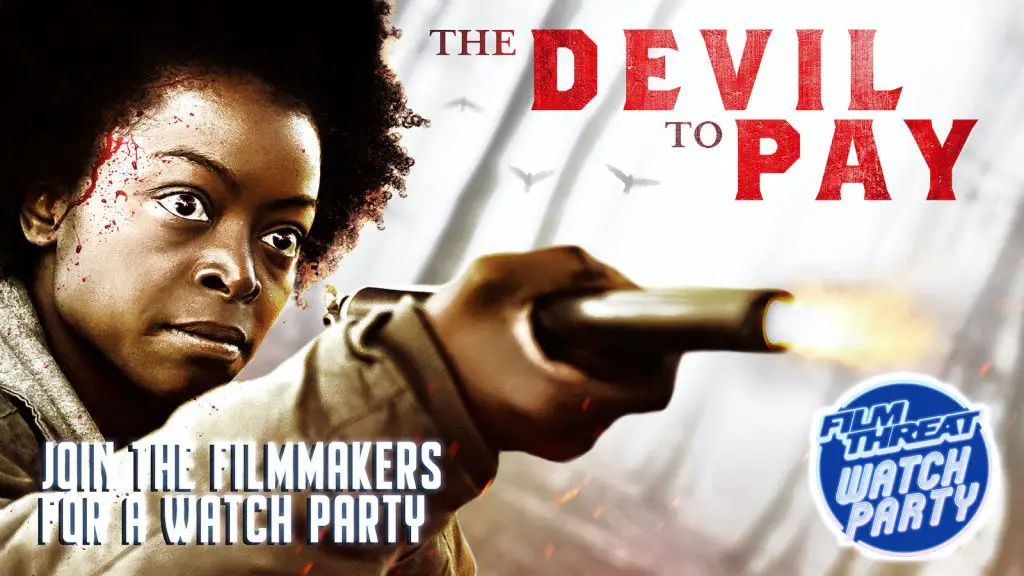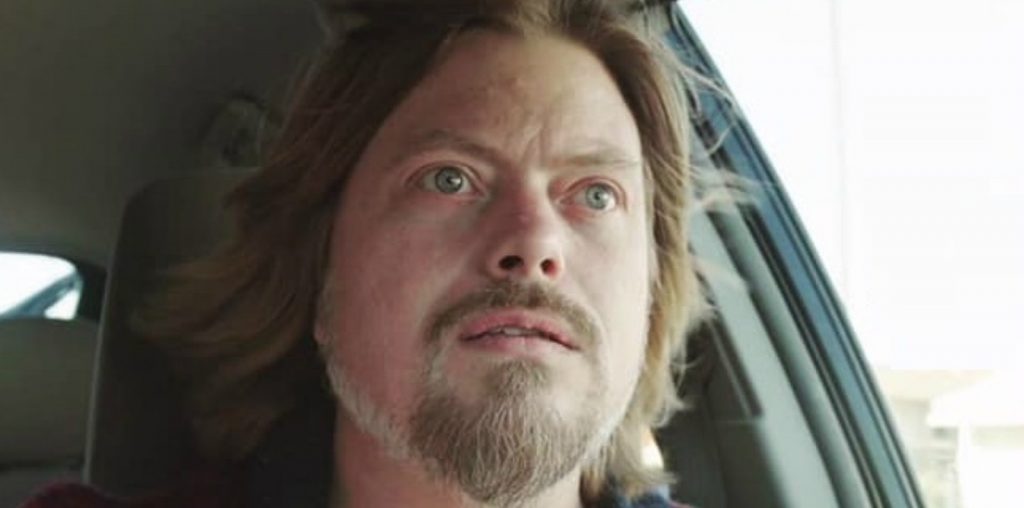
Other scenes in Derailroaded suggest that Fischer was aware of the controversy surrounding his career. Of his Zappa sessions, Fischer shows considerable insight. “He liked to shock people,” Larry proclaims in one scene, with a chuckle. “He figured if he made a record with me, it would shock people.”
Meanwhile, many supporters stuck by the erratic, often-volatile man after more sensitive, sensible souls would have turned away. Mumy, sporting a Ric Ocasek-style leather jacket and shades as he’s seen sitting behind a recording studio control board, reflects on the time he drove the legendary singer home from a recording session, only to notice Larry holding a pair of rusty scissors over his head. Mumy also recalls the recording of 1981’s “Pronounced Normal,” in which Larry’s paranoia kicked in with a vengeance. “He thought he heard the subliminal message, ‘This is gonna be a bad circumcision’ (on one of the tracks).” Consequently, he grew suspicious of a plot to have his manhood bobbed off.
Rubin and Lubin are keenly aware that accusations of exploitation might also be hurled in their direction. “Sometimes, we were walking a fine line, in terms of exploitation,” confesses Rubin. There were times when we had to turn the camera off, and stop being filmmakers, and respect Larry as a human being. We didn’t want to humiliate him.”
Lubin agrees. “We wouldn’t have spent three and a half years making a project just to exploit someone for the purpose of making money,” he insists. “I think that just because someone works with a manic-depressive or a paranoid schizophrenic – someone with a mental illness – it’s very easy to say, ‘That person exploited them.’ Then again, without Barnes & Barnes, and Frank Zappa, and us, who would have talked to Larry? What would Larry have talked about if he didn’t have his music? What would have become of him?”
“The more you do films on this subject,” explains Rubin, “like we did, the more you humanize the subjects and bring a face to them. You get people to deal with the issues, and possibly bring some kind of good out of it all. When faced with a manic depressive person or a paranoid schizophrenic, their first reaction is fear. That’s rooted in ignorance. When you put a face to the illness – and put music to the illness – you get a different reaction out of people. A lot of people have come to us after this film is screened, and say, ‘I never thought of going up to the guy on my street corner who sings to himself all the time, and actually talking to him. I never thought much about that.’ Not that I’m saying that Larry is your average street guy, because I think he is unique. But it is an illness, and people are afraid of what’s different.”
Since the release of 2001’s “A Beautiful Mind,” the subject of schizophrenia instantly went from taboo to mainstream. But do people really understand the disease, even after this commercial depiction of its most common characteristics of paranoia and delusions? “A lot of people do not understand what schizophrenia really is,” insists Rubin. “They get it confused with other diseases. They think that a person with schizophrenia has several different personalities. Or that they always hear voices.”
Hearing voices – or auditory stimuli, as it’s called in psychiatric circles – is a common, but not essential, component of schizophrenia. Sufferers hear things that aren’t there. They harbor beliefs that are inflexible to logic or reality testing. However, they don’t struggle with the multiple personalities that films like “Me, Myself, and Irene” associate with the disease. “That movie was B.S.,” insists Rubin, “because the condition it was showing was not schizophrenia, but multiple personality disorder. It had nothing to do with schizophrenia. Schizophrenia is a complex disease that people are still investigating and trying to cure. Our of all the human illnesses, the mental illnesses are still the farthest from being understood.”
“Derailroaded” forces viewers to grapple with other difficult philosophical questions. For example, would Larry have been better off without his Wild Man persona? Certainly, the pressures of show business aren’t kind to mental health consumers, and it’s likely that his quest for stardom prompted more anxiety than the symptomatic man could handle. Meanwhile, Wild Man’s push to maintain his manic state of “triple pep” saw him refuse to take psychotropic medications, which he felt squelched his creativity. However, Larry’s music did provide a passion and catharsis for the man. He forged an identity with his unique musical dabblings, and lived a life beyond the anonymous routine of group homes and meager SSI checks that the mentally ill often fall into. Is that such a bad thing?
In her thought-provoking book “Touched with Fire,” author Kay Redfield Jameson explores the connection between mood disorders and creativity. A Professor of Psychiatry whose personal bouts with bipolar disorder have been well documented, Jameson examines a prominent cluster of 19th Century Romantic poets that includes Lord Byron and John Clare. While Jameson doesn’t whitewash the problematic aspects of the illness, she also suggests that without the fiery mental dynamics that these subjects accessed, the resulting works of art would be far less striking.
“The manic stage of his manic depression is what gives Larry his ‘high highs,’ that really fuel his art,” explains Lubin, who states that his film subject also spoke of experiencing “racing thoughts,” and “memories all jumbled together.” One can’t help but link these descriptions to Jameson’s more clinical commentary: “The importance of rapid, fluid, and divergent thought in the creative process has been described by most psychologists and writers who have studied human imagination.”
Jameson’s book eventually tackles the theme of genetic engineering, and its capacity to wipe bipolar disorder from the face of the earth. “Certainly it is unclear what the alleviation of highly intense emotional experiences – including ecstatic or visionary states, psychosis, severe melancholia, or other types of mental suffering – might do to the ultimate nature of artistic _expression as well as to the motivations underlying the production of work of art.” The message is clear: do we really want to live in a world void of Wild Man Fischer?
The war that bipolar artists wage between creativity and stability has been well documented on both film and paper. Last year’s “DIG!” featured Brian Jonestown frontman Anton Newcombe, whose musical genius was sabotaged by his physical and verbal attacks on other collaborators. Even so, Newcombe refused medication. “DIG!” director Ondi Timoner gives a typical explanation. “I think he feels it would take away his edge.”
Neurologist Oliver Sacks also explored this struggle in his book, “The Man Who Mistook his Wife for a Hat and other Clinical Tales.” Describing Tourette’s sufferer “Witty Ticcy Ray,” Sacks vividly described the jarring, uncontrollable tics that this patient endured on a regular basis. The frustrating symptoms did have one significant upside: they improved Ray’s ability to improvise complicated jazz rhythms behind a trap set. Eventually, however, Tourette’s more problematic side prompted Ray to seek treatment. He was prescribed Haldol, which effectively reduced the tics. Unfortunately, it also neutered the man’s wild, bravura drumming. Eventually, Ray achieved a compromise, going off medication during weekend drumming gigs, but returning to Hadol on weekdays.
Like Witty Ticcy Ray, Fischer walked a similar tightrope between sanity and artistic _expression. For forty years following his diagnosis, the songwriter refused to take antipsychotic medication. “I think he knew that if he took meds,” suggests director Lubin, “he would lose the essence of what made him Wild Man Fischer.”
Ultimately, “Derailroaded” pulls viewers away from the macro entertainment world that attracts viewers (the Ubin Twinz are the first to admit that it’s Zappa’s popularity – and not Fischer’s – that sells the film) and into the personal, micro circle of Larry’s loved ones. Like “Murderball,” the ferocious yet tear-jerking trek through the world of wheelchair rugby, “Derailroaded” culminates in a powerful emotional finale.
We meet angelic Aunt Josephine, whose wisdom and understanding of Larry are enough to prompt tears. We’re touched by this wonderful woman’s thoughtfulness as she take Larry in during a particularly dark chapter in his life. She saves a collection of his albums, because, as she puts it, “he was always losing them.” She champions Larry, proclaiming her nephew “very creative.” She urges him to continue writing songs to keep his mind going. Even as she resides in a hospital, attached to an oxygen machine, she’s more concerned with her visibly anxious relative than she is with her own state of health. It’s a heartbreaking, soul-stirring, and wonderful moment.
To discover how the “Derailroaded” saga concludes, viewers won’t get their answers here. Only a screening of the film will bring such closure. But Lubin hints at how the Wild Man Fischer legend wraps up. “The ending might be sad if you’re a fan of Wild Man Fischer’s music. But it’s a happy ending if you see Larry as a mentally ill man who needs help.”
“I think that right now,” the producer says of the talented icon that he has so remarkably immortalized onto the screen, “Larry has decided that it’s time to be Larry Fischer, and not Wild Man Fischer.”

